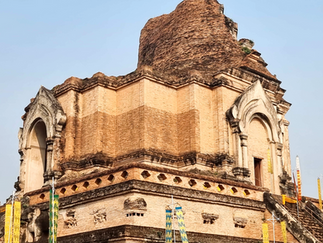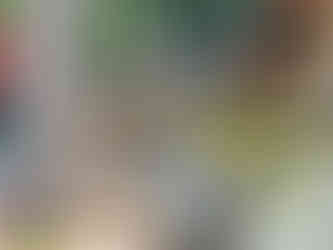Temple of the Great Stupa - Wat Chedi Luang
- shan157
- Apr 6
- 4 min read
Updated: 2 days ago
Commissioned during the reign of King Saen Muangma in the twilight of the 14th century, this ancient royal monastery is one of Chiang Mai’s most hallowed temples. It was conceived not merely as a place of worship, but as a towering tribute, a sacred reliquary meant to enshrine the ashes of the king’s father, the revered King Ku Na. The centrepiece was to be a monumental stupa, ambitiously imagined to rise “as high as a dove could fly.” But fate intervened. Before the dream could be realised, the King met his death. The grand vision may have faltered but it did not die. His devoted widow took up the mantle, breathing life back into the project, ensuring their legacy would ascend with the stone.

Nearly a century after the temple’s founding, it was King Tilokaraj who finally fulfilled its original grand vision, completing what would become the Lanna Kingdom’s first true medieval skyscraper. Rising to a height of 82 metres, the towering pagoda transformed the temple into a spiritual and political beacon, officially declared the royal sanctuary of the Lanna kings. Built beside the former royal palace, it symbolised the sacred bond between divine power and earthly rule and became a masterpiece of craftsmanship. Mythical stone Nagas (guardians of the sacred) flank the sweeping staircases on either side, while from the southern wall, a dramatic row of royal stone elephants appears to surge forth from the base of the chedi. Their presence, like the towering structure they guard, speaks of power, devotion and a kingdom’s determination to etch its legacy into the skies.
In 1468, Thailand’s most sacred relic, the Emerald Buddha, was enshrined in the eastern niche of the chedi’s walls, not only to sanctify the temple but to legitimise King Tilokaraj’s reign and serve as a divine palladium for the kingdom. Its presence transformed the site into the spiritual stronghold of Lanna, radiating both religious reverence and royal authority. But the monument’s majesty was not immune to time or turmoil. In 1545, during the brief reign of Queen Regent Chiraprapha, a violent force, whether a devastating earthquake or the thunder of cannon fire, rattled the foundations of Chiang Mai. In a single catastrophic moment, the upper half of the massive brick chedi collapsed, leaving a shattered crown atop what had once been the kingdom’s most commanding structure.

In 1552, following the political upheavals that fractured the Lanna Kingdom, the semi-precious green stone idol was taken by the King of Laos and carried across the Mekong, where it remained in exile for over two centuries. Its absence marked a profound loss, not just of a relic, but of the divine protector that once legitimised royal power. It wasn’t until 1784, under the unifying force of the Chakri dynasty, that the Emerald Buddha was installed in Bangkok’s Wat Phra Kaew with great ceremony, becoming the spiritual heart of the Thai nation. Tthe story came full circle centuries later, when in 1995, to mark the 600th anniversary of the great chedi’s construction, a black jade replica of the Buddha was ceremonially returned to the eastern niche where the original once sat.
The Viharn Luangpu Mun Bhuridatto, named in honour of the highly revered meditation master Luangpu Mun Bhuridatto, stands as a sacred space of reflection and devotion. Within its walls are enshrined several significant Buddha relics, most notably a sacred molar tooth, believed to embody the spiritual essence of the Enlightened One. A serene statue of Luangpu Mun presides over the space, offering a focal point for contemplation and reverence. The viharn itself was constructed in 1858 during the reign of Prince Chao Kawirorotsuriyawong of the Thip Chang dynasty, reflecting both the royal patronage of Buddhism and the enduring legacy of monastic wisdom that continues to shape northern Thailand’s spiritual landscape.

Over the course of its tumultuous 600-year history, the temple compound evolved into a layered tapestry of sacred architecture. Additions over the centuries included the revered Sao Inthakin City Pillar, elaborately carved Viharns, a constellation of shrines and sacred Dipterocarp trees believed to house protective spirits. In the early 1990s, major reconstruction efforts were initiated with funding from UNESCO and the Japanese government. However, conflicting visions over architectural authenticity and preservation philosophy led to a decisive outcome, the great chedi would remain in its partially ruined state, a solemn and powerful reminder of impermanence and a monument as much to its history as to its resilience.
Location : 103 Prajadhipok Road, Si Phum, Mueang, Chiang Mai
How to get there : Wat Chedi Luang is situated in the middle of the walled Old City in Chiang Mai, about 10 minutes walk from the Pae gate. If you don't want to walk, take a taxi or a tuk-tuk to Ratchadamnoen Road. The temple grounds can be found about halfway down that road with the entrance almost directly opposite Phra Pok Klao Road.
Attraction Info : The temple grounds are open daily between 6am - 6pm. The entry fee is 40 baht for adults and 20 baht for children. The temple remains free to visit for Thai nationals. Be sure to dress respectfully.
วัดเจดีย์หลวง
Thanks for reading Temple of the Great Stupa - Wat Chedi Luang. Check out more destinations here!





















